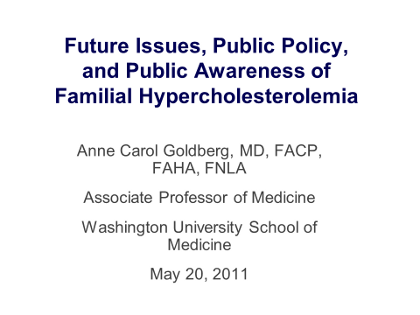Goldberg - Figure 1 - Introduction to Familial Hypercholesterolemia Text
In the May 2011 issue of its official journal, the Journal of Clinical Lipidology, the National Lipid Association announced a new set of recommendations regarding the screening, diagnosis, and treatment of familial hypercholesterolemia (FH). The impetus for these recommendations came from the Foundation of the National Lipid Association (FNLA). The FNLA was created in late 2008 to serve as an education and research organization in the field of lipidology, with an emphasis on serving professional, community, and public health interests. The FNLA focuses on the complex overall medical conditions that result from disorders of lipid metabolism, known by the general term dyslipidemia, and on the associated disorders of the cardiovascular system. The mission of the FNLA is to conduct educational activities designed to enhance and promote medical understanding and efforts to prevent cardiovascular events and death from disorders of lipid metabolism and the cardiovascular system.
Why should we be focusing specifically on the subset of lipid disorders known as FH? The first reason is the greatly increased risk of cardiovascular disease (CVD) and death that is associated with the presence of FH. FH is an inherited genetic disorder that results in pathologically high serum cholesterol concentrations, with the expected greatly increased risk of premature coronary heart disease (CHD). The condition is not so rare that it will not be seen in ordinary clinical practice. Since approximately 1 in 500 people has FH, in the United States there are an estimated 600,000 people who are affected.
If unrecognized and left untreated, FH results in substantially increased risk of CVD events in both men and women, leading to their occurring at much younger ages than in the general at-risk population without FH. The mean age of onset of CVD events in men with FH is the early 40s and in women with FH it is the early 50s. In the presence of the FH phenotype there is a 20-fold increase in the risk of an MI before age 40. The second reason to focus on FH is because FH is in fact a treatable disease. At present it is too often underdiagnosed and undertreated, but the evidence shows clearly that earlier recognition and appropriate treatment can decrease the risk of developing CHD. The goal of the FNLA’s FH campaign is to raise awareness of FH as a family cholesterol issue and to motivate patients and families to talk about the condition. We want to increase public awareness of FH, encourage those at risk to explore their family cholesterol history, and for all those with FH or at risk for FH, we want to stimulate them to increase their interactions with their families, other patients, and doctors and finally, to seek out and find a lipid expert.
The NLA policy statement was developed from a meeting of an FH expert panel of people with expertise in treatment of patients with FH. The panel included participants with both clinical and research backgrounds, bench research, and clinical research; pediatric and adult medicine practitioners; people in academic and private practice; physicians, a nurse, a pharmacist, representation from several parts of the country including all 5 NLA regional chapters, and people with expertise in genetics, pharmacology, LDL apheresis, epidemiology, public health, clinical trials, and pediatrics. The panel focused on 5 areas:
- public policy and genetics testing
- diagnosis and screening
- treatment options
- management of FH in adults
- management of FH in pediatrics
